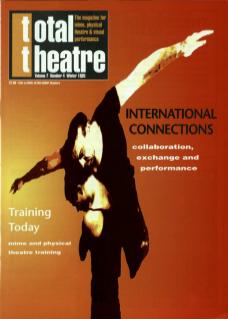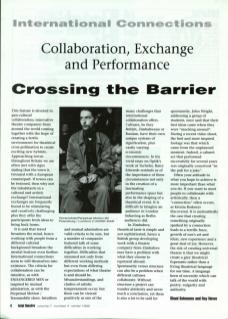This feature is devoted to pan-cultural collaboration – innovative theatre companies from around the world coming together with the hope of creating a fertile environment for theatrical cross-pollination to create exciting new hybrids. Approaching towns throughout Britain we are often met with signs stating that the town is twinned with a European counterpart. If towns can be twinned, then why not the inhabitants in a cultural and artistic exchange? International exchanges are frequently found to be stimulating and creatively challenging plus they offer the participants fresh ideas to bring back home.
It is said that travel broadens the mind, hence working with people from a different cultural background broadens the mental horizon even further. International connections seem to will themselves into existence. The criteria for collaboration can be intuitive, as with Endangered Men, or inspired by mutual admiration, as with the Perpetual Motion / Terramobile show. Intuition and mutual admiration are valid criteria to be sure, but a number of companies featured talk of some difficulties in working together. Difficulties that stemmed not only from different working methods but even from differing expectations of what theatre is and should be. Misunderstandings, and clashes of artistic temperaments occur, but these can be viewed positively as one of the many challenges that international collaboration offers. Cultures, be they British, Zimbabwean or Russian, have their own unique systems of signification, plus vastly varying economic circumstances. In his vivid essay on Optik's work at Tacheles, Barry Edwards reminds us of the importance of these circumstances not only in the creation of a fascinating performance space but also in the shaping of a theatrical event. It is difficult to imagine an audience in London behaving as Berlin audiences did.
In Zimbabwe, theatrical taste is simple and not sophisticated, hence a British group developing work with a theatre company from Zimbabwe may have a problem with what they choose to represent abroad. Spontaneity versus structure can also be a problem when different cultures collaborate. Without structure a project can wander aimlessly and never reach a conclusion, yet there is also a lot to be said for spontaneity. John Wright, addressing a group of students, once said that their best ideas came when they were ‘mucking around’. During a recent video shoot, the best and most inspired footage was that which came from the unplanned moment. Indeed, a cabaret act that performed successfully for several years was originally conceived ‘in the pub for a joke’.
Often your attitude to what you hope to achieve is more important than what you do. If you want to meet people to collaborate with artistically, then a ‘connection’ often occurs, as Krizsta Bodonyi discovered. It is undoubtedly the case that creating something originally sparked by a connection leads to a terrific buzz, growth of one's art and ideas, new experience, and a great deal of joy. However, the risk of creating universal theatre is that we might create a grey theatrical Esperanto rather than a living theatrical language for our time. A language born of necessity which can talk of the world with poetry, vulgarity and authority.

